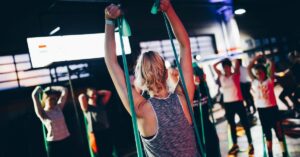Breakthrough Techniques in Mental Fitness That Athletes Swear By

Breakthrough Techniques in Mental Fitness That Athletes Swear By
When we think of athletes, the first images that typically spring to mind are those of their incredible physical prowess—sprinting down a track, sinking a three-pointer, or executing a flawless dive. But what often remains in the shadows is an equally crucial component of their success: mental fitness. It’s a fascinating, sometimes overlooked aspect of sports that can make or break a performance. I mean, we’ve all heard stories of champions who falter under pressure, right? Well, it turns out that a lot of these athletes are turning to some pretty innovative mental fitness techniques to gain an edge. Let’s dive into the world of mental fitness and explore the breakthrough techniques that athletes are swearing by.
The Power of Visualization
Visualization is like the secret sauce of mental fitness. Athletes have been using this technique for decades, even if they didn’t always call it that. The concept is simple yet profound: by vividly imagining themselves executing skills perfectly, athletes can enhance their actual performance.
Take Michael Phelps, for instance. The Olympic swimmer has often spoken about how he would visualize every race in detail, right down to the feeling of the water against his skin. “I can see the race unfold in my mind,” he said once during an interview, “and I take that mental image into the pool.” Imagine waking up every morning and picturing your day going perfectly; it’s a lot like that, but with Olympic-level stakes. And trust me, it’s not just for show. Research indicates that mental imagery can activate the same neural pathways in the brain as actual practice, making it a powerful tool for enhancing performance.
How to Get Started with Visualization
So, how can one tap into this mental fitness technique? Here’s a quick rundown:
- Find a quiet space: You need an environment where distractions are minimal. Think of it as your mental gym.
- Close your eyes: Seriously, this is essential. It helps you focus better.
- Visualize in detail: Picture the sights, sounds, and even smells of your sport. Feel every muscle and movement.
- Practice regularly: Consistency is key. Try to set aside time daily for this mental exercise.
Some athletes even incorporate visualization into their warm-up routines. Picture the scene: a basketball player stands at the free-throw line, eyes closed, imagining the ball sailing through the net. It’s a simple act, but it can be incredibly effective.
Mindfulness and Meditation
Let’s shift gears a bit—mindfulness and meditation are two buzzwords that have crept into the athletic lexicon over the past few years. And for good reason! Both techniques help athletes hone their focus and manage stress, which can be as crucial as physical training.
Take the example of NBA star LeBron James. He’s been known to practice mindfulness to keep his mind sharp amidst the chaos of the NBA playoffs. “It helps me stay in the moment,” he once remarked. “There’s so much noise around, but mindfulness helps me cut through it.”
Research supports this notion. Studies suggest that mindfulness can significantly reduce anxiety and improve focus—a must-have combo for any competitive athlete. The beauty of mindfulness is its versatility; it can be integrated into training sessions or even during competition. Yes, even during a high-stakes game!
Getting Started with Mindfulness
If you’re intrigued by the idea of mindfulness, here’s how to begin:
- Start small: Even just a few minutes a day can make a difference. Focus on your breath and let thoughts come and go.
- Use guided meditations: There are countless apps and online resources that can help guide you through the process.
- Be patient: This is a skill that takes time to develop. Don’t get discouraged if your mind wanders.
Embracing mindfulness may just lead to that “aha!” moment, where clarity cuts through the fog of competition.
Goal Setting: The SMART Way
Every athlete knows that setting goals is crucial, but there’s a method to the madness that can make all the difference. Enter the SMART goals framework—Specific, Measurable, Achievable, Relevant, and Time-bound. It’s a systematic approach that helps athletes create a clear path to success.
Let’s break it down. Imagine a runner who wants to improve her 5K time. Rather than saying, “I want to run faster,” she could set a SMART goal like, “I want to run a 5K in under 25 minutes within three months.” This goal is specific (a clear target time), measurable (she can track her progress), achievable (with training, this is possible), relevant (it aligns with her overall desire to improve), and time-bound (she has a deadline).
This method not only provides clarity but also keeps athletes motivated. It’s like having a roadmap in a world where every turn can feel overwhelming. I remember a friend who was training for a marathon. He started with vague aspirations and soon found himself feeling lost. Once he implemented SMART goals, everything changed—he had a direction.
Crafting Your Own SMART Goals
Want to give it a shot? Here’s a simple step-by-step:
- Identify your objective: What do you want to achieve?
- Make it specific: Pinpoint the details.
- Ensure it’s measurable: How will you track progress?
- Check its achievability: Is it realistic?
- Add relevance: Why does this goal matter?
- Set a timeline: When do you want to achieve it?
With SMART goals, athletes can transform nebulous dreams into tangible achievements.
Embracing Positive Self-Talk
We all have that little voice in our heads, right? Sometimes it’s cheering us on, and other times, well, not so much. The way athletes harness this internal dialogue can dramatically affect performance. Positive self-talk is a technique that encourages athletes to replace negative thoughts with affirmations and constructive feedback.
Take Serena Williams, for example. She’s known for her fierce determination and mental strength. In interviews, she often mentions how she talks to herself during matches, pushing away doubts. “I tell myself I can win,” she said. “It’s like having a personal cheerleader.”
Studies show that positive self-talk can enhance motivation, increase confidence, and even improve overall performance. It’s not about ignoring challenges; rather, it’s about facing them with a more empowered mindset.
How to Cultivate Positive Self-Talk
Here’s how you can start transforming that inner critic into a supportive coach:
- Recognize negative patterns: Awareness is the first step. Listen to what you’re saying to yourself.
- Challenge the negativity: Ask yourself if those thoughts are true. Often, they’re not.
- Replace with affirmations: Write down positive statements and repeat them often.
- Visualize success: Pair positive self-talk with visualization for even greater impact.
Once athletes start embracing positive self-talk, it can feel like a mental weight has been lifted. They become their own biggest fans.
Resilience Training
We hear a lot about resilience in sports, but what does it really mean? At its core, resilience is the ability to bounce back from setbacks. Athletes face numerous challenges—injuries, losses, and even mental blocks. The ability to recover quickly and adapt is what sets the greats apart from the rest.
Consider Tom Brady, a quarterback whose career has been marked by both incredible successes and tough losses. He’s often mentioned his belief in resilience, famously stating, “I’ve learned that if you just keep pushing forward, you can overcome anything.” In fact, it’s his mentality after setbacks that has made him a legend.
Training for resilience involves mental exercises that strengthen one’s ability to cope with adversity. This might include reflecting on past challenges and how one overcame them, or even practicing scenarios where things don’t go as planned.
Building Resilience: Practical Steps
If you want to cultivate resilience in your athletic journey, consider these steps:
- Reflect on past challenges: Consider how you’ve handled difficulties before and what you learned.
- Practice adaptability: Try new strategies and be open to change. It’s okay to pivot!
- Setbacks are part of the game: Embrace them as learning opportunities rather than failures.
- Surround yourself with support: Build a network of friends, coaches, and mentors who encourage resilience.
Resilience training can transform an athlete’s approach to challenges, making them not just survivors but thrivers in their sport.
Breathing Techniques
Ah, breathing! It’s something we do naturally, yet it can be a game-changer when it comes to performance. Athletes are increasingly turning to specific breathing techniques to enhance focus, reduce anxiety, and improve endurance.
Take the world of yoga, for instance. Many athletes have embraced practices like pranayama, which focuses on controlled breathing. A well-known advocate of this technique is Novak Djokovic, who integrates focused breathing into his tennis routine. He believes it helps him maintain composure during high-pressure moments. “It’s all about balance,” he once said. “Breath is life.”
Research supports the effectiveness of breathing techniques. Studies suggest that controlled breathing can lower heart rates, reduce stress, and even improve athletic performance. It’s a simple yet profound tool that can be practiced anywhere—before a big game, during a tough workout, or even in daily life.
Simple Breathing Techniques to Try
Ready to give it a go? Here are a few techniques to experiment with:
- Deep Belly Breathing: Sit or lie down comfortably. Inhale deeply through your nose, allowing your belly to rise. Exhale slowly through your mouth.
- Box Breathing: Inhale for four counts, hold for four counts, exhale for four counts, and hold again for four counts. Repeat.
- 4-7-8 Breathing: Inhale for four counts, hold for seven counts, and exhale for eight counts. This technique is particularly useful for calming nerves.
Breath control may seem simple, but once athletes master it, they can wield it like a powerful weapon against anxiety and distraction.
The Role of Nutrition in Mental Fitness
Let’s talk about food—after all, you are what you eat, right? Nutrition plays a crucial role in mental fitness. Certain foods can enhance cognitive function, improve mood, and even help with focus. Athletes are increasingly aware that what they put into their bodies can have a huge impact on their mental game.
Consider the likes of elite athletes who prioritize a balanced diet rich in omega-3 fatty acids, antioxidants, and vitamins. Foods such as salmon, blueberries, and leafy greens are staples in their diets. I once had a chat with a nutritionist who mentioned how important it is for athletes to see food as fuel for both body and mind. It seems that a well-fed brain is a happy brain!
Research indicates that a diet rich in whole foods can positively influence mood and cognitive performance. On the flip side, diets high in processed foods can have the opposite effect—leading to fatigue and poor concentration.
Nutrition Tips for Mental Fitness
Want to boost your mental fitness through nutrition? Here are some pointers:
- Prioritize whole foods: Focus on fruits, vegetables, lean proteins, and whole grains.
- Stay hydrated: Dehydration can lead to fatigue and mental fog. Drink plenty of water!
- Incorporate brain-boosting foods: Foods rich in omega-3s (like fish) and antioxidants (like berries) can support cognitive function.
By understanding the link between nutrition and mental fitness, athletes can fuel their bodies—and their minds—for optimal performance.
Conclusion: The New Frontier of Mental Fitness
As we’ve explored, the world of mental fitness is rich with techniques that athletes are adopting to gain a competitive edge. From visualization and mindfulness to resilience training and nutrition, these methods are not just fads; they’re backed by research and real-world success stories. It’s a fascinating blend of science and art, where the mind’s power is harnessed to enhance physical performance.
The landscape of sports is evolving, and mental fitness is becoming an integral part of training regimens for athletes at all levels. It’s a reminder that while physical talent is essential, the mind is just as crucial in the quest for excellence. So, whether you’re a weekend warrior or an aspiring Olympian, consider embracing these breakthrough techniques. After all, every athlete wants to perform at their best, and sometimes, the greatest victories come from within.
As I wrap up this exploration of mental fitness, I can’t help but reflect on my own journey—how many times have I battled my inner critic or struggled to maintain focus during challenging times? It seems we all have our own version of the athlete’s struggle. But with the right techniques, we can all learn to win that battle, one breath at a time.






